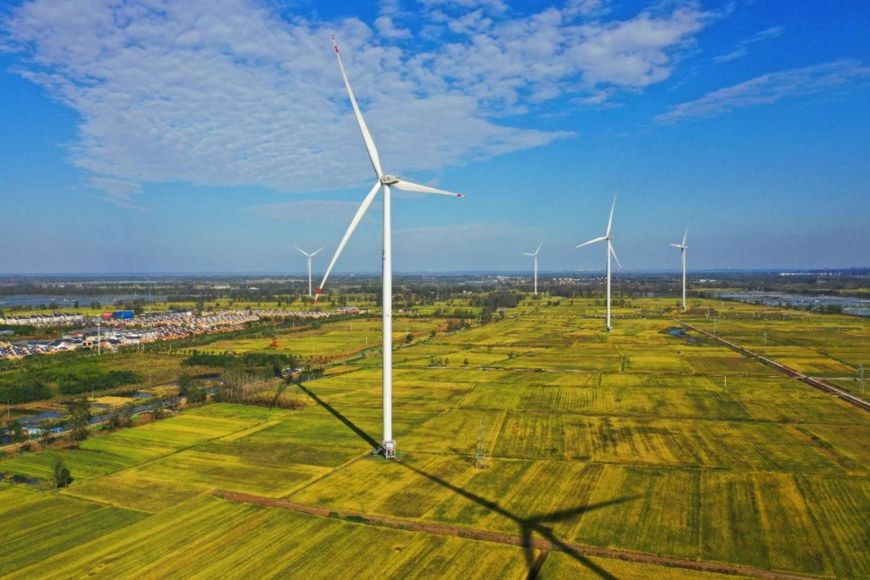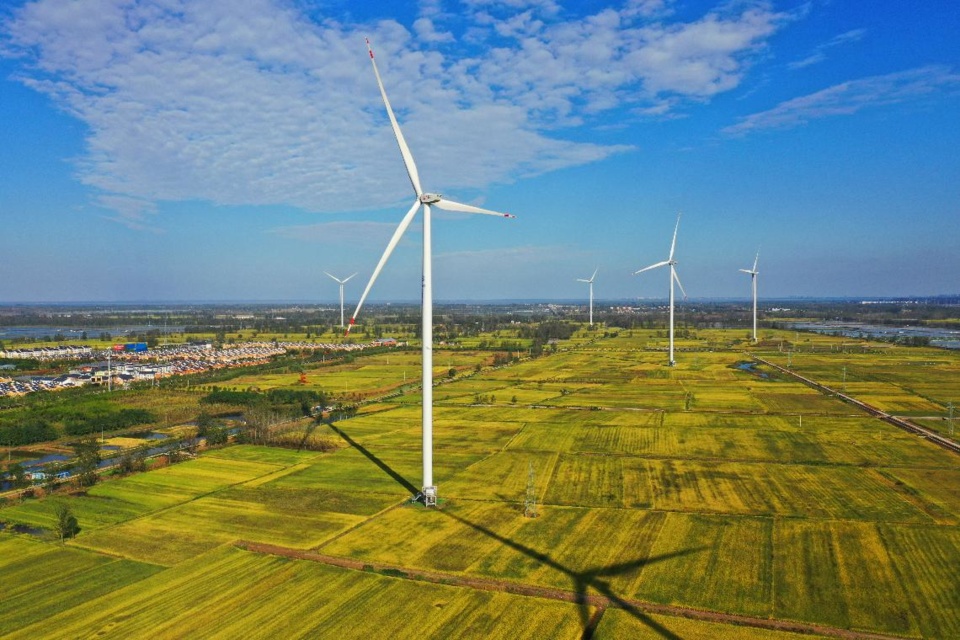By Kou Jiangze, Liu Yi, People’s Daily

Photo shows wind turbines at a wind farm in Weiji township, Suining county, Xuzhou city, east China’s Jiangsu province, Oct. 11, 2021. (Photo by Hong Xing/People’s Daily Online)
With its heat exchanger units in efficient operation, a newly built energy relay station of a thermal power plant in Shijiazhuang city, north China’s Hebei province, is transferring clean heat source to a huge number of households across the city.
“Since it was put into operation in October 2021, the new project has provided heating service for more than 600,000 residents from 220,000 households. It can help save 1.14 million tons of standard coal per year, thus significantly reducing the emissions of greenhouse gases, including carbon dioxide,” said Liu Wendong, deputy director of the urban management bureau of Shijiazhuang and director of the city’s heating supply center.
In response to climate change, a common challenge facing humanity, China pledges to peak carbon emissions before 2030 and achieve carbon neutrality before 2060. While representing China’s solemn commitment to the world, the goals also signal extensive and profound economic and social transformations.
Since the announcement of the goals, relevant departments in various areas of the country have coordinated efforts to peak carbon dioxide emissions and achieve carbon neutrality and progressed in an orderly manner toward the goals.
By adopting more vigorous policies and measures, they have pushed economic and social development based on efficient use of resources and green and low-carbon growth.
Deep in Kubuqi Desert in Ordos, north China’s Inner Mongolia autonomous region, row upon row of blue solar panels of a leading photovoltaic power base stretch out as far as one can see. Located in Dalad Banner of Ordos city, the base, with solar panels covering an area of nearly 50,000 mu (about 3,333 hectares), has continuously transferred clean energy to users.
In June 2021, five individual projects of the base were all successfully connected to power grid and started supplying electricity to consumers. With an annual power generation capacity of two billion kWh, the base can save 680,000 tons of standard coal, which is equivalent to a reduction of 1.77 million tons of carbon dioxide emissions.
Adopting a model that combines photovoltaic power generation and ecological restoration, the base has helped improve the ecological environment of 60,000 mu of areas in the Kubuqi Desert, according to Sun Guodong, a man in charge of the operation and maintenance of the base.
China’s clean energy development has accelerated constantly. By the end of November 2021, the country’s installed wind power capacity and solar power capacity had reached about 300 million kWh and 290 million kWh respectively, rising 29 percent and 24.1 percent respectively year on year.
Data released by China’s national new energy consumption monitoring and early warning center showed that the country’s national utilization rates of wind power and photovoltaic power generation in the first 10 months of 2021 were 97 percent and 98 percent, respectively.
On July 16, 2021, China’s national carbon market started online trading. The first batch of trading among over 2,000 power companies involved about 4.5 billion tons of carbon dioxide emissions, making the carbon market the world’s largest one in terms of the amount of greenhouse gas emissions covered.
As of December 20, 2021, the market had witnessed transactions for a cumulative total of 130 million tons of carbon emission quotas worth more than 5.5 billion yuan ($862.95 million).
Carbon emissions trading is an important means of reducing greenhouse gas emissions through market-based mechanism, said an official with China’s Ministry of Ecology and Environment. On the basis of sound performance of the carbon market for the power sector, transactions on the market would be expanded to gradually include participants from more carbon-intensive industries and more types of “goods”, according to the official.
“Dead branches of trees can easily cause fire and breed plant diseases and insect pests. They must be removed quickly so that the wood will grow better and have stronger carbon sink capacity next year,” said Dao Erkun, senior engineer at the forestry and grassland administration of Bole city, northwest China’s Xinjiang Uygur autonomous region, explaining why workers were busy clearing dead branches from an artificial wood on a pasture in Bole city.
Forests and grasslands, among other natural ecosystems, are important for the realization of the carbon emission peaking and carbon neutrality goals. Various localities and departments in China have taken effective measures and made positive progress in large-scale afforestation campaigns.
As of December 2021, the country had planted 54 million mu of forests and 46 million mu of grasslands, completing its annual goal.
China plans to green 500 million mu of land during its 14th Five-Year Plan period (2021-2025), with 100 million mu of land being greened annually, said Zhang Wei, head of the ecological protection and restoration department of China’s National Forestry and Grassland Administration.
At the same time, efforts will be made to promote science-based approaches in tending and managing forests, improve the quality of forests, and enhance the carbon sink capacity of forests, according to Zhang.
Preliminary calculation revealed that during the first three quarters of 2021, China’s energy consumption per unit of GDP decreased by 2.3 percent year on year and the proportion of clean energy consumption in the country’s total energy consumption rose 0.6 percentage points from the same period of the previous year; in the first 10 months of 2021, the average PM2.5 density of 339 cities at or above the prefecture level dropped by 6.7 percent year on year to 28 micrograms per cubic meter, while the share of good air quality days of these cities reached 87.5 percent on average.
“Since it was put into operation in October 2021, the new project has provided heating service for more than 600,000 residents from 220,000 households. It can help save 1.14 million tons of standard coal per year, thus significantly reducing the emissions of greenhouse gases, including carbon dioxide,” said Liu Wendong, deputy director of the urban management bureau of Shijiazhuang and director of the city’s heating supply center.
In response to climate change, a common challenge facing humanity, China pledges to peak carbon emissions before 2030 and achieve carbon neutrality before 2060. While representing China’s solemn commitment to the world, the goals also signal extensive and profound economic and social transformations.
Since the announcement of the goals, relevant departments in various areas of the country have coordinated efforts to peak carbon dioxide emissions and achieve carbon neutrality and progressed in an orderly manner toward the goals.
By adopting more vigorous policies and measures, they have pushed economic and social development based on efficient use of resources and green and low-carbon growth.
Deep in Kubuqi Desert in Ordos, north China’s Inner Mongolia autonomous region, row upon row of blue solar panels of a leading photovoltaic power base stretch out as far as one can see. Located in Dalad Banner of Ordos city, the base, with solar panels covering an area of nearly 50,000 mu (about 3,333 hectares), has continuously transferred clean energy to users.
In June 2021, five individual projects of the base were all successfully connected to power grid and started supplying electricity to consumers. With an annual power generation capacity of two billion kWh, the base can save 680,000 tons of standard coal, which is equivalent to a reduction of 1.77 million tons of carbon dioxide emissions.
Adopting a model that combines photovoltaic power generation and ecological restoration, the base has helped improve the ecological environment of 60,000 mu of areas in the Kubuqi Desert, according to Sun Guodong, a man in charge of the operation and maintenance of the base.
China’s clean energy development has accelerated constantly. By the end of November 2021, the country’s installed wind power capacity and solar power capacity had reached about 300 million kWh and 290 million kWh respectively, rising 29 percent and 24.1 percent respectively year on year.
Data released by China’s national new energy consumption monitoring and early warning center showed that the country’s national utilization rates of wind power and photovoltaic power generation in the first 10 months of 2021 were 97 percent and 98 percent, respectively.
On July 16, 2021, China’s national carbon market started online trading. The first batch of trading among over 2,000 power companies involved about 4.5 billion tons of carbon dioxide emissions, making the carbon market the world’s largest one in terms of the amount of greenhouse gas emissions covered.
As of December 20, 2021, the market had witnessed transactions for a cumulative total of 130 million tons of carbon emission quotas worth more than 5.5 billion yuan ($862.95 million).
Carbon emissions trading is an important means of reducing greenhouse gas emissions through market-based mechanism, said an official with China’s Ministry of Ecology and Environment. On the basis of sound performance of the carbon market for the power sector, transactions on the market would be expanded to gradually include participants from more carbon-intensive industries and more types of “goods”, according to the official.
“Dead branches of trees can easily cause fire and breed plant diseases and insect pests. They must be removed quickly so that the wood will grow better and have stronger carbon sink capacity next year,” said Dao Erkun, senior engineer at the forestry and grassland administration of Bole city, northwest China’s Xinjiang Uygur autonomous region, explaining why workers were busy clearing dead branches from an artificial wood on a pasture in Bole city.
Forests and grasslands, among other natural ecosystems, are important for the realization of the carbon emission peaking and carbon neutrality goals. Various localities and departments in China have taken effective measures and made positive progress in large-scale afforestation campaigns.
As of December 2021, the country had planted 54 million mu of forests and 46 million mu of grasslands, completing its annual goal.
China plans to green 500 million mu of land during its 14th Five-Year Plan period (2021-2025), with 100 million mu of land being greened annually, said Zhang Wei, head of the ecological protection and restoration department of China’s National Forestry and Grassland Administration.
At the same time, efforts will be made to promote science-based approaches in tending and managing forests, improve the quality of forests, and enhance the carbon sink capacity of forests, according to Zhang.
Preliminary calculation revealed that during the first three quarters of 2021, China’s energy consumption per unit of GDP decreased by 2.3 percent year on year and the proportion of clean energy consumption in the country’s total energy consumption rose 0.6 percentage points from the same period of the previous year; in the first 10 months of 2021, the average PM2.5 density of 339 cities at or above the prefecture level dropped by 6.7 percent year on year to 28 micrograms per cubic meter, while the share of good air quality days of these cities reached 87.5 percent on average.
 Menu
Menu
 China pushes ahead with carbon peak, neutrality in orderly manner
China pushes ahead with carbon peak, neutrality in orderly manner
















